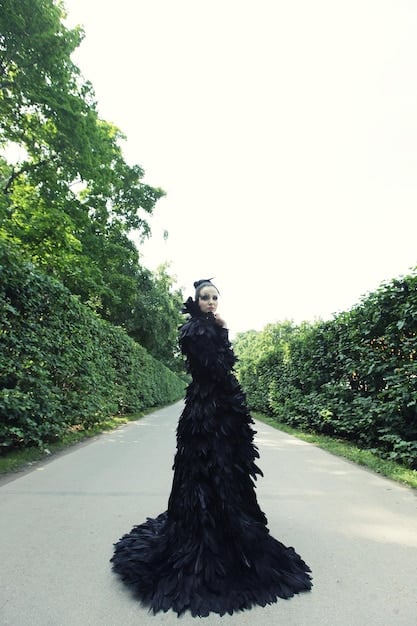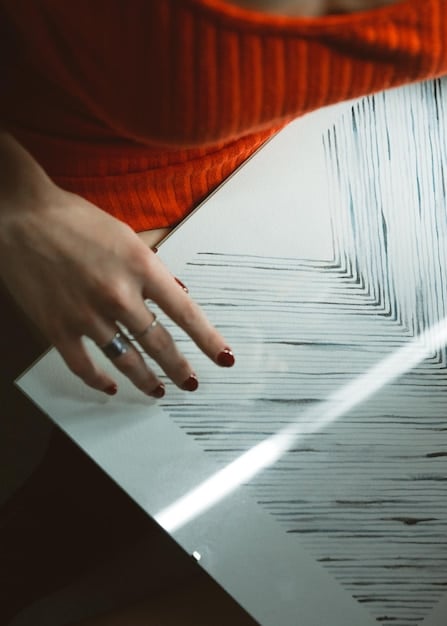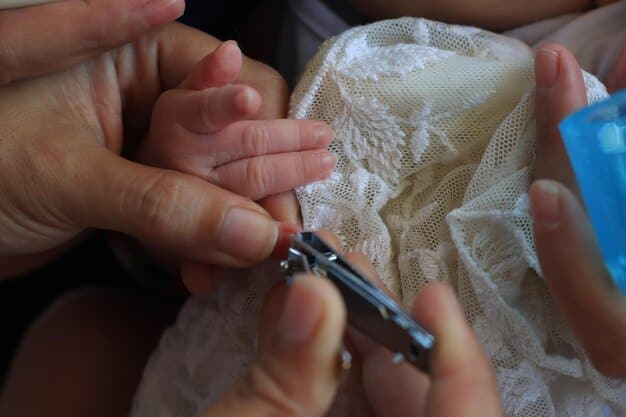Million-Dollar Couture: A Top Designer’s Creative Process

The design process behind a $1 million couture gown by a leading US designer involves intricate steps from initial sketch to final embellishment, blending artistry, technical skill, and client collaboration to create a unique, high-value garment.
Ever wondered how a couture gown reaches a million-dollar price tag? This insider look: the design process behind a $1 million couture gown by a leading US designer unveils the meticulous craftsmanship, artistic vision, and client collaboration that transforms a sketch into a wearable masterpiece.
Crafting the Vision: The Initial Design Phase
The journey of a million-dollar couture gown begins not on the runway, but within the sketchbooks and mood boards of a visionary designer. This initial design phase is crucial, setting the stage for the intricate process that follows.
It’s a dance between the designer’s creative impulse and the client’s personal style, culminating in a design that is both innovative and deeply personal.
Concept Development and Inspiration
Inspiration can strike from anywhere – art, nature, travel, or even a fleeting emotion. The designer translates these inspirations into initial sketches, exploring silhouettes, fabrics, and embellishments.
Client Collaboration and Customization
Couture is inherently personal. The designer collaborates closely with the client, understanding their vision, preferences, and body type. This ensures the final gown is a perfect reflection of the client’s individuality.
- Initial consultations to understand client preferences and event details.
- Presentation of sketches and fabric samples for client feedback.
- Detailed measurements and fitting assessments for a bespoke design.
- Iterative design adjustments based on client input and designer expertise.
The initial design phase is a delicate balance of creativity and collaboration, resulting in a blueprint for a truly unique couture creation.

Selecting the Finest Materials: The Fabric and Embellishment Stage
Once the design is finalized, the quest for the perfect materials begins. This stage is critical, as the quality and artistry of the fabrics and embellishments significantly contribute to the gown’s overall value and aesthetic.
The designer seeks out rare and exquisite materials that elevate the gown to a work of art.
Sourcing Exclusive Fabrics
Couture fabrics are often sourced from around the world, chosen for their unique texture, drape, and quality. Silk, lace, and velvet are staples, but the designer may also seek out specialty fabrics with unique weaves or finishes.
Handcrafted Embellishments and Detailing
Embellishments are where couture truly shines. From intricate beadwork to delicate embroidery, these details are meticulously handcrafted by skilled artisans, adding depth and dimension to the gown.
- Sourcing of rare and precious gemstones for embellishments.
- Hand embroidery using silk threads and gold accents.
- Application of delicate lace appliques with meticulous precision.
- Custom-designed beadwork patterns to enhance the gown’s silhouette.
The fabric and embellishment stage is a testament to the dedication and artistry that goes into crafting a million-dollar couture gown. The selection of luxurious materials elevates the design, making it truly exceptional.
Pattern Making and Muslin Mock-Up: Perfecting the Fit
With the design and materials in place, the focus shifts to pattern making and creating a muslin mock-up. This critical step ensures the gown fits the client perfectly, allowing for adjustments and refinements before cutting into the precious fabrics.
The muslin mock-up serves as a three-dimensional canvas, bringing the design to life and revealing any potential fit issues.
Creating a Bespoke Pattern
Unlike mass-produced clothing, couture relies on patterns drafted specifically for the client’s measurements. This ensures a precise and flattering fit that accentuates the wearer’s best features.
The Muslin Fitting Process
A muslin mock-up, made from inexpensive fabric, is created based on the pattern. The client tries on the muslin, allowing the designer to assess the fit and make necessary adjustments.
- Precise measurements taken to create a custom pattern.
- Construction of a muslin mock-up to test the design.
- Multiple fittings to ensure perfect fit and comfort.
- Adjustments made to the pattern based on fitting feedback.
Through meticulous pattern making and muslin fittings, the designer ensures the final gown will not only look stunning but also feel comfortable and empowering to wear.
The Art of Construction: Assembling the Couture Gown
The construction phase is where the gown truly takes shape. Skilled seamstresses and tailors meticulously assemble the pieces, bringing the designer’s vision to life with precision and care.
This stage requires patience, expertise, and an unwavering commitment to perfection.
Hand Sewing Techniques and Detailing
Couture relies heavily on hand sewing techniques, allowing for greater control and precision than machine stitching. Intricate details are meticulously hand-stitched, ensuring a flawless finish.
Fitting Refinements and Adjustments
Throughout the construction process, the gown undergoes multiple fittings. The designer and client collaborate to make further refinements, ensuring the final fit is impeccable.

The art of construction is a labor of love, requiring countless hours of meticulous work. The result is a gown that is not only beautiful but also a testament to the skill and dedication of the artisans involved.
Embellishment and Finishing Touches: Adding the Sparkle
With the gown constructed, the final stage involves the application of embellishments and finishing touches. This is where the gown gains its sparkle and personality, transforming it into a true work of art.
From shimmering beads to delicate feathers, these details add depth, dimension, and a touch of magic.
Beadwork, Embroidery, and Appliqués
Skilled artisans painstakingly apply beads, embroider intricate patterns, and attach delicate appliqués. These details are often handcrafted, adding a unique and personal touch to the gown.
Final Touches and Quality Control
The final touches include pressing, steaming, and ensuring every detail is perfect. Rigorous quality control ensures the gown meets the highest standards of craftsmanship.
- Application of hand-sewn beadwork and sequins.
- Embroidery with silk threads and metallic accents.
- Attachment of delicate lace and feather appliqués.
- Final quality control to ensure perfection.
The embellishment and finishing touches elevate the gown to a new level of luxury and artistry. The meticulous attention to detail ensures it is a true masterpiece, ready to grace the red carpet or a special occasion.
The Grand Reveal: Presenting the Million-Dollar Gown
The culmination of months of work, the grand reveal is a moment of pure magic. The client beholds their bespoke couture gown for the first time, a reflection of their personal style and the designer’s vision.
It’s a moment of joy, pride, and unforgettable beauty.
The Final Fitting and Presentation
The final fitting ensures the gown fits perfectly and feels comfortable. The designer presents the finished gown to the client, revealing the culmination of their collaborative journey.
Care and Maintenance Instructions
Couture gowns require special care and maintenance. The designer provides detailed instructions to ensure the gown remains in pristine condition for years to come.
- Final fitting to ensure perfect fit and comfort.
- Presentation of the completed gown to the client.
- Delivery of the gown in a custom-designed garment bag.
- Instructions for professional cleaning and storage.
The grand reveal is a celebration of artistry, craftsmanship, and personal style. The million-dollar couture gown is not just a garment; it’s a symbol of luxury, exclusivity, and the power of collaboration.
| Key Aspect | Brief Description |
|---|---|
| 🎨 Initial Design | Sketching and collaboration with the client to finalize the design concept. |
| 💎 Material Selection | Sourcing exclusive fabrics and embellishments for a luxurious feel. |
| 🧵 Construction | Hand-sewing and fitting adjustments to achieve a perfect fit. |
| ✨ Final Reveal | Presenting the finished gown to the client. |
Frequently Asked Questions
▼
Designing a million-dollar couture gown can take several months, often ranging from three to six months, depending on the complexity of the design and client availability for fittings.
▼
The high cost is due to the use of rare materials, extensive handwork, bespoke patterns, and the expertise of skilled artisans. Personalized design also factors into the pricing.
▼
Yes, client involvement is essential. Designers collaborate closely with clients in understanding all preferences, providing feedback, and ensuring the final gown aligns perfectly with their vision.
▼
Popular fabrics include silk, lace, velvet, and specialty materials. These are sought after for their drape, texture, and quality. Many of the most exclusive come from europe.
▼
Designers source embellishments worldwide, seeking rare gemstones, handcrafted beads, and unique appliqués. These elements add depth and sparkle to the gown, enhancing its overall value.
Conclusion
The design process behind a million-dollar couture gown is a fascinating blend of artistry, technical skill, and collaboration. From the initial sketch to the final reveal, every detail is carefully considered and executed to create a truly unique and timeless masterpiece. It’s an investment in art that is cherished and admired forever.





